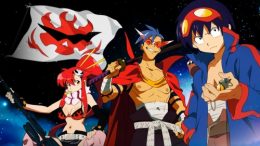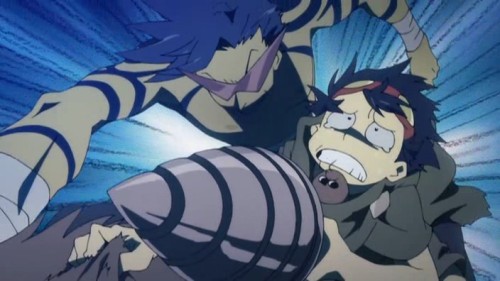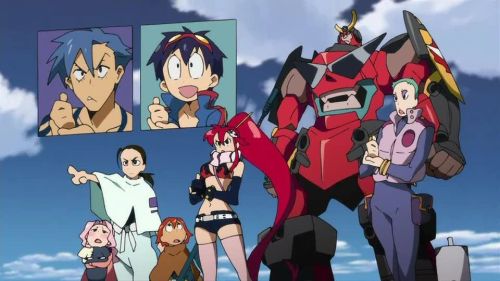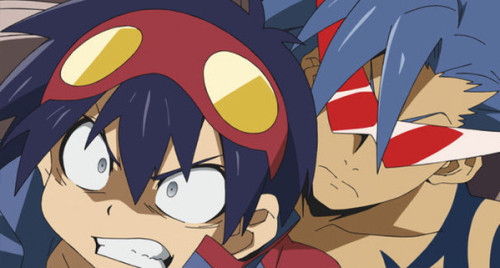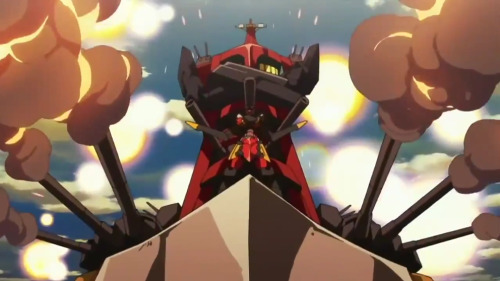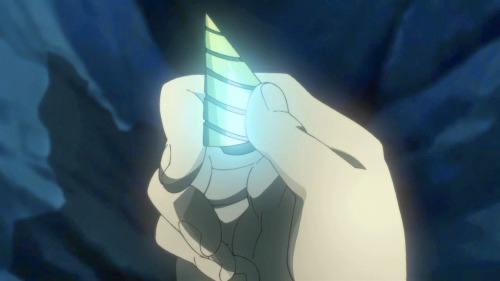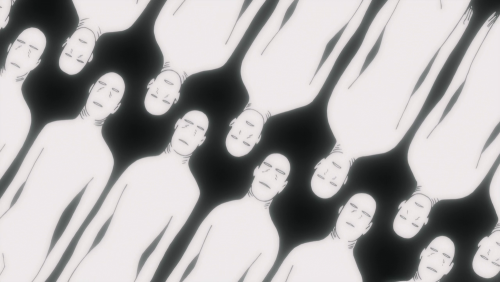The Way of the Gang in Tengen Toppa Gurren Lagann
Posted By Buttercup Dew On In North American New Right | Comments DisabledTengen Toppa Gurren Lagann (more frequently Gurren Lagann) is a 2007 fantasy adventure by Gainax. It’s an explosive, white-knuckle roller-coaster ride of mecha action, as well as featuring stunning dialogue and character design. An indirect spiritual successor to Neon Genesis Evangelion, Gurren Lagann dispenses with the anxious tension of its predecessor, yet retains the same central gimmick of mecha robots as a metaphor for fighting will; the setting is shifted from contemporary Tokyo (and in Evangelion’s case, from an underground and mechanized “geofront” known as Tokyo-3), to a barren and largely empty post-apocalyptia where humans are forced to live underground. It is in the grim catacombs of one such isolated village (seemingly made of nothing but excavated mud) where we are introduced to the protagonists Simon and Kamina, the soul of Gurren Lagann’s outrageous first season.
Simon and Kamina are opposites in temperament, yet combine to make the head and heart of Gurren Lagann – both the show and its titular primary mecha robot, or “Ganmen” (literally “face”). Kamina’s boisterous, vocal, and “indomitable masculinity” plays a big-brother, guardian role to the younger, introverted, and untested Simon, and the first season’s arc follows Simon’s adoption by Kamina into his Gurren Gang, Kamina’s leadership and legacy, and Simon’s eventual self-realization as his own man: climbing out from under Kamina’s shadow to carry on his name and (in his own words) “spirit.” Yet “spirit” is too weak a word, and the phrase “fighting spirit” is an oxymoron that ought to be abolished from the English language. A spirit is an idea, an abstraction (a Geist), and the fighting of Gurrenn Lagann is intensely physical. Simon, Kamina, and men the world over share “fighting spirit” in the embodied sense of physical courage, a bodily revulsion and stomach-churning disgust at the thought of stepping back, accepting what they deem unacceptable, and kowtowing to the world presented to them “as it is.”
Kamina has seen the open sky just once in his life, and has become a young punk spreading subversion around the village chief (an aging thug), who maintains there is no such thing as “the surface.” Simon is a digger who operates a hand-cranked drill, excavating further tunnels to expand the village. Together with some other misfits and teens, they attempt to bust through the ceiling and reach the surface, only for a giant Ganmen robot operated by a beast-man to come down and start wrecking the primitive place. Yes, humans are forced to live underground by literal beast-men in giant robots with faces. It’s that sort of show.
The third main protagonist, Yoko, a boobalicious babe with an oversized sniper rifle, is quickly introduced in this first episode, and the rudimentary Gurren Brigade is born. A totem Simon has excavated – a small, spiral, drill-shaped key – leads them to discover a pilotable robot, the diminutive Lagann (a cool name that Kamina “came up with just now”), and Yoko’s acrobatic firepower, Kamina’s inexhaustible morale, and the drill weapon combined cause Lagann to manifest through force of will and affinity. The Ganmen robot is defeated, and they bust out of their underground prison. They encounter more Ganmen and begin to make their way through the dangerous world.
On plenty of occasions, Kamina (the towering source of the Kamina Glasses meme) puts himself fully in harm’s way and has to be rescued by Simon at the last second, because his “unwavering resolve” and overestimation of his own fighting ability will not allow him to back down. Or does it? Kamina is later shown not to be an idiot unaware of his own limits. In private, he discloses that his encouragement of Simon when they were trapped underground, when he was helpless to assist, was a “false show of courage.” Kamina feels pain like anyone else, yet laughs off injury and apparently inevitable death – perhaps not out of foolhardiness, but because a world where he was let down by his partner, where demonstrating unwavering conviction was insufficient to inspire others to conquer their fear, is not a world in which he would want to remain.
Yoko, too, is an anime creation. Female snipers, whilst common in many armed forces, are not the ideal expression of femininity, and Yoko’s breasts are played for fanservice and comedy throughout the series. She only assumes a more serious female role in the second season, when relative stability allows her to become a teacher (allowing for more genuine conversation with an older man who “finds it harder to watch his mouth with age”). She forgoes having children in order to fight until late in the second season. When Yoko rides back into battle on a levitating scooter, it carries home that Gurren Lagann is a show for energetic teens embroiled in the conflicts of their lives; they define themselves in opposition to the world and in struggling against its injustices.
Simon and Kamina always win – perhaps too easily to maintain dramatic tension, as the show’s central point is that indomitable resolve always inevitably leads to victory. But where Neon Genesis Evangelion was Hideo Anno’s discussion of depression and a lesson to teenagers learning to like themselves, Gurren Lagann is a triumphant celebration of recklessness, youth, and fighting against all odds. If fighting is sure to result in victory, then you must fight![1] [4] For Kamina, victory is always assured because the enemy lacks tenacity – the will and reason to fight. The Ganmen patrolling the wasteland are beast-men, brawlers without conviction, and in the first season, the ultimate enemy of the Gurren Brigade is Lord Helix (or Genome, depending on which translation you go with), who is keeping humans (who are all anime white or Asian-colored) suppressed in a continual police action. For Kamina, who comes face to face with his father’s skull and grave in the middle of a brutal conflict, defeat is not an option.
The weakest character by far is Rossiru, who was raised in a village that performed ritual sacrifice to remain at a steady fifty people, as permitted by Malthusian resource scarcity – in the complex and cohesive (yet less engaging) second season of the show, he turns traitor and stages a coup against Simon and the Gurren Gang. All he knows how to do is manage what there is to manage, and never stake what little he has in a make-or-break conflict. Far too much forgiveness is shown to his cowardly character, but that’s Japanese sympathy for legalism and seeing things in a ridiculously black-and-white way. (The flipside to having a tidy society with perfect civic virtue can be a stifling conservatism and risk-aversion. As they say in Japan, the nail that sticks out gets hammered down.)
After Kamina bests a beast-man in a fight and steals his Ganmen, he attains the “Gurren” Ganmen, and the two mechas combine to create “Gurren Lagann.” His bold and previously unthinkable action inspires copycats, including Kittan, the leader of the Black Kinsmen (three sisters and their elder brother, actually), another proto-clan in the wastes and an example of the show’s broad-strokes setup of roaming gangs. The beast-men they encounter are initially caricatures of blacks and aborigines, who are abstracted just enough to fly under the censors’ radar (but of course these wonky, black, thick-lipped beasties would never, ever appear in any Western cartoon).
Kamina, leading the small, yet growing, Gurren Lagann Brigade, a gang of Ganmen-stealing humans, decide that Lord Helix’s flagship, the dai-Gurren, is too tempting a target to simply destroy and capture in a titanic battle. Simon’s anxiety that Kamina has stolen his love interest, Yoko, clouds his concentration until Kamina, mortally wounded, punches him back to his senses, reminding him that he would never abandon him and that nothing matters more to him than their partnership (or, to mongrelize the English language, that he puts bros before hos). Kamina’s life has been saved by Simon multiple times at this point, so cartoon action or not, the loyalty is well-deserved. Kamina recognizes in Simon a latent strength that he has yet to accept himself, and it is this certainty that animates him.
As the show’s introduction narrates, Simon is “fighting against his destiny” – perhaps it is every boy’s destiny to grow into a proper man, and it only fails to manifest when it is shirked out of a combination of misguided fear and complacency? Kamina states that he is “doing what is natural to him,” and that it “feels good.” In the words of Max Stirner:
Why does a human need more time than is necessary to refresh his labour power? Here communism is silent. Why? To take pleasure in himself as unique, after he has done his part as a “human being”![2] [6]
They struggle not out of a moralistic duty, but mere preference; the combatants of the Gurren Gang are not bound by contract, oath, or any higher allegiance other than simply tagging along for shits, giggles, and glory. Kamina’s indomitable resolve represents a “Way,” superior strength of character, and natural aristocracy: an expression of extreme masculinity.
(Spoilers ahead!)
Kamina’s death is sudden and unexpected. After he is introduced, the viewer is led to believe that he is the main character who will lead the Gurren Gang to final victory, and perhaps even have a child with Yoko (she is distraught and heartbroken after he dies in combat). It’s an interesting twist which reveals that the true intent of the story is to show Simon’s self-realization. Kamina’s sacrifice to capture the dai-Gurren secures his Gang a future: it is a mobile operating base with food, quarters, and self-sustaining repair capabilities, being a walking battleship studded with cannons to see off enemies and press on the capital of Lord Helix, Teppelin. His conquest leads to the founding of his own civilization, even though he does not live to see it. It secures his legacy, so long as the Gurren Gang is faithful to his name and “Way,” even though it struggles with aimlessness (along with Simon, too, struggling with a crippling existential ennui), until Kamina’s “fighting spirit” is again embodied by Simon.
It is worth nothing that the Kanji (written character) for dai, or “big,” is pictographic as a person with arms outstretched, similar to the way the Algiz, or Life Rune, is pictographic as a person with arms stretched upwards, embracing the Sun. The character, depending on context, is alternately used for “big,” “heaven,” “day,” or “sky,” and is alternately translated in the show as “Great Gurren Brigade.” The connotations are such that when a background character refers to the Gang as simply “Gurren Brigade,” Yoko slams her fists on the table in anger and shouts, “It’s dai-Gurren Brigade!”
Aboard the Dai-Gurren, the second in command (the former leader of the Black Kinsmen, Kittan) struggles to fill Kamina’s boots, and Simon falls into a deep depression. He loses all will to live and is eventually abandoned by the crew. Even upon his return with the mysterious and empty-headed Nia (a beautiful and abandoned Princess of Lord Genome, a “doll” for amusement), he spends his time in his room doing what he has always done: digging (in his case, piles of dirt brought onto the ship for reasons unknown). Kittan, whilst a naturally strong and tough guy, is unable to lead from the heart with the conviction that Kamina had, and when his authority is questioned, he is forced to admit that he is simply standing in while the Gang awaits new leadership: “It’s what Kamina would have done.”
We then flash back to Simon, digging with his hand-cranked drill in his native village, trapped in the earth. There is no greater danger to Simon than being buried underground and dying of exhaustion, similarly to how his parents were killed by a Ganmen-induced earthquake. Kamina is helpless to assist him, yet is outwardly certain they will escape if Simon simply presses on. His encouragement and bravado pushes Simon to do what he is truly capable of, and they eventually break through to safety.
Likewise, in the hard work both of life and the metapolitical struggle, victory can be as near as a few feet, without one knowing it. There is no way to know beyond seemingly irrational conviction; there is nothing to do except either complacently wait for the end, or to press on regardless of the pain or slim chances of success. As Simon says, “Nearly zero percent? That is as good as a hundred percent to me!”
Later, the Gurren Gang is captured, doomed to a humiliating public execution after having been tricked. They cannot dig themselves out of the bedrock of their underground prison regardless of how hard they try. Only Simon’s totem, the activating drill-key to the Lagann, can scrape away at the hard ground. He keeps digging himself out of the depression and entrapment, persisting given that fate has offered him the slimmest of chances (even when everyone around him has given up in despair).
The small scrape of the drill bit against the earth eventually breaks through to salvation. Simon recovers the Lagann and is able to deliver a decisive blow against his captors. Not only this, but he is able to throw off the burden he has placed on himself in becoming “like Kamina.” Thoughtful and self-contained (almost a sulky child), his knowledge that he could never be the extroverted, loud, and natural social success that Kamina was cripples him until he realizes – through digging – that he is fine as he is. He is able to embody the unwavering resolve of Kamina, but in his own way; in digging his way to freedom, he finds his “Way” of being, of never compromising or accepting defeat. He comes to believe in Kamina’s Gurren Gang slogan (translated in a hilariously clunky way as “Surpass the Impossible and Kick ‘Reason’ to the Kerb”) and comes to believe in himself; both in his first nature as a contemplative person and in his second as a digger. He steps into the leadership of the Gurren Gang and guides the Brigade into mortal combat with their oppressor, Lord Helix, emerging victorious – but just barely.
It’s hard to overstate how explosively loud and visually dazzling Gurren Lagann is. Nearly every episode involves barrages of robot-to-robot weaponry and mecha martial arts. The show frequently lampshades the writing’s cliché of having Simon’s “ability to always succeed at the last second,” but despite this, there are more than enough twists and turns among the main and supporting cast to make the show emotionally gripping as well as visually arresting. The first season’s relentless action is also wonderfully varied and recalls the best of Evangelion: the birdman, lizard-lady, and armadillo arch-foes make for contrasting and complex action sequences in air, sea, and on land.
The second season, which is set after a seven-year time-jump, which allows Simon’s Gurren Gang to found the government of a new civilization, delves deeper into the show’s lore. It introduces new, literally faceless enemies, Tron-style shapes from another dimension rendered in computer graphics which are far less engaging than the beast-men. During the final battle sequences, the lore almost collapses upon itself into a shapeless puddle of cosmic nonsense, but luckily the show’s simple message holds it all together.
The show’s central power is named (midi-chlorians!) as “Spiral power,” and given a nemesis in the “Anti-Spirals”; it’s mashed in with a hodgepodge about how “Spiral beings” (namely humans) are driven by evolution, and so have to be held in check by deceit. It doesn’t make a lick of sense until the realization sets in that the Japanese love to conflate the “will to life” in “evolution” with embodied physical courage. The “Anti-Spirals’” goal is “Total Demoralization,”[3] [9] so that the Spiral beings (us) will never rise above learned helplessness and organize against the you-know-whos. In Gurren Lagann, they have hijacked a real human from their Interdimensional Interzone to describe their plan of creating “Absolute despair, by crushing your hopes one by one.”
The only identity of this rootless interdimensional clique is that of negation, of being Anti-Spiral. They are incapable by nature of living like a normal nation, so the central conflict in the second season is against the Anti-Spiral’s “Human Extermination System,” triggered when the goyim begin to multiply into an existential threat. These schemers and liars have such chutzpah in Gurren Lagann that they have stolen the Moon and replaced it with a fake. The Anti-Spirals live in constant fear that they will be found out; knowing they lack the will to fight, they rely on ruses, technical trickery, the housebroken, and the duped to do their dirty work for them. The Anti-Spiral is the broken image of the Spiral, and leads a deformed, parasitic existence as a hysterically paranoid control addict. These interdimensional gangsters have given up on life and peddle the falsehood that all manly courage will lead to destruction, knowing that a direct confrontation is a losing battle. They willingly surrender their humanity to keep the Spirals in check through apathy, fear, and hopelessness.
In the final conflict, the Anti-Spirals have trapped Simon in a dreamworld. He is presented with two choices: an illusory life with an imaginary Kamina, a petty crook dragging him through a life of profitable theft. This fake apologizes profusely to the police, disingenuously begging for his life (something to which the real Kamina would never lower himself). He grabs Simon and pushes his face towards the dirt, sneering at him, “You should beg, too! Pretend to apologize, we just have to survive!” The memory of the real Kamina appears, asking, “What’s wrong, Simon? Have you forgotten? We’re the legendary Gurren Brigade of Jiiha Village!” Simon’s soul isn’t so easily bought, and he punches the lights out of the phony harassing him. Kamina reminds him cryptically that “[m]y universe is the same as yours, and theirs,” gesturing to all the comrades who have lived and died in the way of the Gurren Brigade.
We live in the same world of Spiral struggle, knowing that the last great battle in the final war is the inner conflict between courage and despair. So, to all my compatriots in the immortal and mighty dai-White Gang fighting the corrosive, Anti-Spiral parody “civilization”: “Surpass the Impossible and Kick Reason to the Kerb,” and remember the true nature of Spiral power: defiance!
Notes
[1] [11] “Sun Tzu said that. And I think he knows a little more about fighting than you do, sunshine, because he invented it.”–The Soldier, Team Fortress 2.
[2] [12] Here, Stirner is using the phrase “human being” disparagingly to refer to someone living in accordance with the doctrinal spirit of “human decency,” serving only the morality they have elevated above them, and not themselves. From The Unique and Its Property, tr. Wolfi Landstreicher (Baltimore, Md.: Underworld Amusements, 2017).
[3] [13] William S. Burroughs, Naked Lunch. I don’t wish to advertise the whole of this ridiculously unpleasant book, but it has a few good commentaries.
Source: https://buttercupdew.tumblr.com/post/180591062303/the-way-of-the-gang-in-tengen-toppa-gurren-lagann [14]
